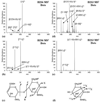Differentiation of 3-O-sulfated heparin disaccharide isomers: identification of structural aspects of the heparin CCL2 binding motif
- PMID: 19185514
- PMCID: PMC2758813
- DOI: 10.1016/j.jasms.2008.12.002
Differentiation of 3-O-sulfated heparin disaccharide isomers: identification of structural aspects of the heparin CCL2 binding motif
Abstract
The presence of 3-O-sulfated glucosamine residues in heparin or heparan sulfate plays a role in binding to antithrombin III and HSV infection. In this study, tandem mass spectrometry was used to differentiate between two heparin disaccharide isomers containing variable sulfate at C6 in a common disaccharide and C3 in a more rare one. The dissociation patterns shown by MS(2) and MS(3) were clearly distinguishable between the isomers, allowing their differentiation and quantitation. Using this technique, we show that an octasaccharide with 11 sulfate groups with high affinity for inflammatory chemokine CCL2 does not contain 3-O-sulfated disaccharides.
Figures


References
-
- Chen Y, Maguire T, Hileman RE, Fromm JR, Esko JD, Linhardt RJ, Marks RM. Dengue Virus Infectivity Depends on Envelope Protein Binding to Target Cell Heparan Sulfate. Nature Medicine. 1997;3:866–871. - PubMed
-
- Shukla D, Liu J, Blaiklock P, Shworak NW, Bai X, Esko JD, Cohen GH, Eisenberg RJ, Rosenberg RD, Spear PG. A Novel Role for 3-O-Sulfated Heparan Sulfate in Herpes Simplex Virus 1 Entry. Cell. 1999;99:13–22. - PubMed
-
- Perrimon N, Bernfield M. Specificities of Heparan Sulphate Proteoglycans in Developmental Processes. Nature. 2000;404:725–728. - PubMed
-
- Marcum JA, McKenney JB, Galli SJ, Jackman RW, Rosenberg RD. Anticoagulantly Active Heparin-Like Molecules from Mast Cell-Deficient Mice. The American Journal of Physiology. 1986;250:H879–H888. - PubMed
Publication types
MeSH terms
Substances
Grants and funding
LinkOut - more resources
Full Text Sources
Other Literature Sources
Medical
Miscellaneous

